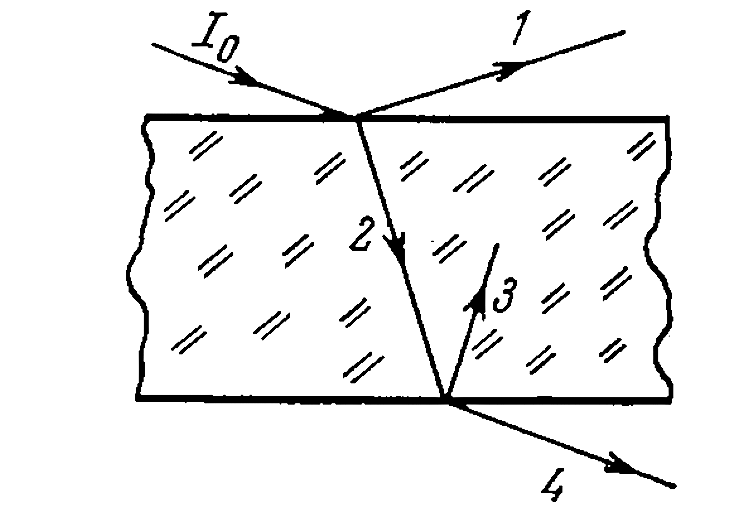A beam of monichromatic light falls normally on the surfcae of a plane-parallel plate of thickness l. The absorption coefficient of the substance the plate is made of varies linearly along the normal to its surfcae from x1 to x2. The coefficient of reflection at each surface of the plate is equal to ρ. Neglecting the secondary reflections, find the transmission coefficient of such a plate.
Apart from the factor (1−ρ) on each end face of the plate, we shell get a factor due to absorptions. This factor can be calculated by assuming the plate to consist of a large number of very thin slab within each of which the absorption coefficient can be assumed to be constant. Thus we sheel get a produced like
............e−χ(x)dxe−χ(x+dx)dxe−χ(x+2dx)dx..........
This produced in nothing but
e−∫l0χ(x)dx
Now χ(0)=χ1,χ(l)=χ2 and variation
with x is linear so χ(x)=χ1+xl(χ2−χ1)
Thus the factor becomes
e−∫l0[χ1+xl(χ2−χ1)]dx=e−12(χ1+χ2)l
Topper's Solved these Questions
- OPTICSBOOK - IE IRODOV, LA SENA & SS KROTOVCHAPTER - OPTICSEXERCISE - Optics Of Moving Sources
22 Videos
- OPTICSBOOK - IE IRODOV, LA SENA & SS KROTOVCHAPTER - OPTICSEXERCISE - Thermal Equation
47 Videos
- OPTICSBOOK - IE IRODOV, LA SENA & SS KROTOVCHAPTER - OPTICSEXERCISE - Polarization Of Light
43 Videos
- MECHANICSBOOK - IE IRODOV, LA SENA & SS KROTOVCHAPTER - MECHANICSEXERCISE - Mechanics Problems
92 Videos
- OSCILLATIONS AND WAVESBOOK - IE IRODOV, LA SENA & SS KROTOVCHAPTER - OSCILLATIONS AND WAVESEXERCISE - Electromagnetic Waves, Radiation
36 Videos
Similar Questions
A beam of monochromatic light passes through a pile of N=5 identical plane-parallel glass plates each of thickness l=0.50cm. The coefficient of reflection at each surface of the plates is ρ=0.050. The ratio of the intensity of light transmitted through the pile of plates to the intensity of incident light is τ=0.55 Neglecting the secondary reflections of light, find the absorption coefficient of the given glass.
View SolutionA point source of monochromatic light emitting a lumninous flux Φ is positioned at the cnetre of a spherical layer of substance. The inside radius of the layer is a, the outside one is b. The coefficient of linear absorption of the substance is equal to x, the reflection coefficient of the surfcaes is equal to ρ. Neglecting the secondary reflections, find the intensity of light taht passes through that layer.
View Solution
Knowledge Check
X-ray beam of intensity I0 passes through an absorption plate of thickness d. If absorption coefficient of material of plant is μ, the correct statement regarding the transmitted intensity l of X-ray is
AI=I0(1−e−μt)BI=I0e−μdCI=I0(1−e−μ/d)DI=I0e−μ/dA beam of light of wavelength 6400 Å is incident normally on a parallel glass plate of 5cm thick and R.I. 1.6. The beam takes the same time to travel from source to incident surface and through the glass plate. The distance of source from incident surface is
A7.5 cmB6 cmC10 cmD8 cm
A narrow beam of natural light falls on the surface of a thick transparent plane-parallel plate at the Brewster angle. Its top surface. Find the degree of polarization of beams 1−4 (Fig.)

View SolutionA beam of light of intensity I0 falls normally on a transparent plane-parallel plate of thickness l. The beam contains all the wavelengths in the interval from λ1 to λ2 of equal spectral intensity. Find the intensity of the transmitted beam if in this wavelength interval the absorption coefficient is a linear function of λ, with exterme values x1 and x2. The coefficient of reflection at each surfcae is equal to ρ. The secondary reflections are to be neglected.
View SolutionA plane electromagnetic wave falls at right angles to the surface of a plane − parallel plate of thickness l . The plate is made of non− magentic substance whose permittivity decreases exponentially from a value ε10 at the front surface down to a value ε2 at the rear one. How lond does it take a given wave phase to travel across this plate gt
View SolutionA plane monochromatic light wave of intensity I0falls normally on a plane-parallel plate both of whose surfaces have a reflection coeffiecient ρ. Taking into account multiple reflections, find the intensity of the transmitted light if
(a) the plate is perfectly transparent, i.e the absorption is absent,
(b) teh coefficient of linear absorption is equal to x, and the plate thickness is d.
View SolutionA narrow beam of natural light falls on a set of N thick plane-parallel glass plates at the Brewster angle. Find:
(a) the degree P of polarization of the transmitted beam,
(b) what P is equal to when N=1,2,5, and 10.
View SolutionA light wave falls normally on the surface of glass coated with a layer of transparent substance. Neglecting secondary reflections, demonstrate that the amplitudes of light waves reflected from the two surfaces of such a laver will be equal under the condition n'=√n, where n' and n are the refractive indiced of the layer and the glass respectively.
View Solution
